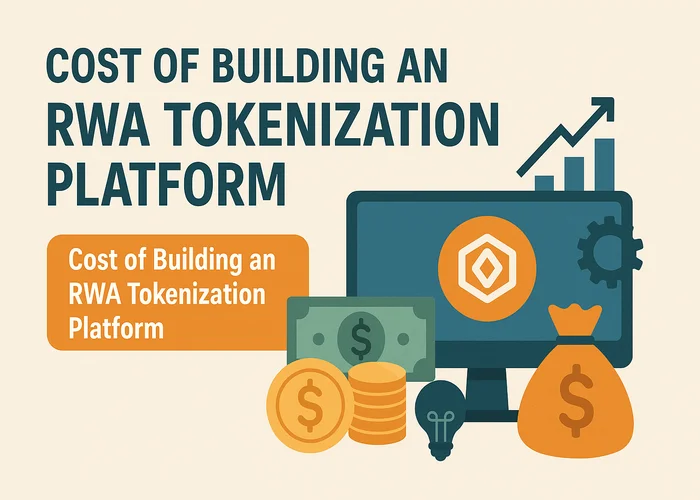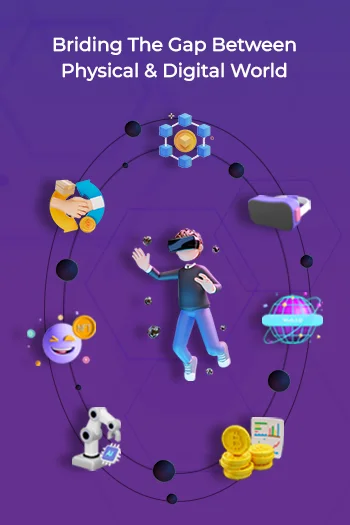Blockchain technology has changed the way RWAs, including as real estate, commodities, artwork, and intellectual property, are digitized. Tokenization turns real-world or off-chain assets into digital assets that live on the blockchain. Tokenizing these assets makes them easier to move, trade, and see through, which allows for fractional ownership, liquidity, administrative efficiency, and market trust.
Tokenization is popular in industries with slow processes, strict rules, and assets that aren’t easy to sell. Blockchain lets you break up commercial real estate and fine art into smaller digital units, which makes it easier to buy, sell, or use as collateral. A financial environment that is more open to everyone welcomes smaller investors and creates new ways to make money.
As tokenization becomes more popular, a number of businesses are thinking in offering RWA platform development services. These platforms handle the costs of onboarding, issuing, managing, and trading tokenized assets. The joy often comes with one big worry:
How much does it cost to build a real-world asset tokenization platform?
What Is an RWA Tokenization Platform?
Before diving into the financial side of things, it’s essential to understand what a Real World Asset (RWA) tokenization development company actually does. At its core, such a platform provides the technology and compliance framework to convert physical assets into digital tokens that represent either partial or full ownership of the underlying asset.
These tokens are created and recorded on a blockchain, ensuring that ownership is transparent, verifiable, and resistant to tampering. The entire lifecycle of these digital tokens from issuance to transfer and redemption is managed through the platform.
A standard RWA tokenization Cost platform typically includes the following features:
- Asset onboarding interfaces that allow asset owners to upload documentation, provide asset valuations, and submit ownership credentials.
- Smart contracts that automatically create tokens, move them around, and do things according on rules, such giving out profits or voting rights.
- Integration of KYC/AML compliance to check users’ identities and make sure the platform follows anti-money laundering rules.
- Token issuance processes that make digital tokens with certain rules and features, such the ERC-20 or ERC-1400 standards.
- Wallets and custody solutions that give users safe places to keep, manage, and use their tokens.
- Marketplaces or secondary trading platforms that let people trade tokenized assets with each other or through the platform.
- Features for following the legislation and rules to make sure the tokens fit all securities laws and any other needs in the area.
Creating a RWA platform development cost in 2025 is a forward-thinking move that bridges physical assets with digital liquidity. It unlocks fractional ownership, global access, and 24/7 trading for traditionally illiquid markets.
Major Cost Components
1. Requirement Planning and Analysis
Approximately $5,000–$20,000
The initial and most important step is Cost of Building an RWA Tokenization Platform. Here, you define your project’s scope, examine viability, and connect your business goals with tokenization’s technological and legal reality.
Consultants, developers, lawyers, and business analysts will help you address questions like:
- Which assets are you tokenizing? Art, commodities, IP, or real estate?
- Which user are you targeting? institutions, retail investors, both?
- Where will you operate and what laws must you follow?
- Do you require a platform or an MVP to test the market?
- Although it doesn’t include coding, this phase is vital for building a solid foundation. Poor planning at this stage might cause misaligned goals, regulatory issues, or costly rework later in development.
2. Blockchain Network Selection and Integration
Cost of Building an RWA Tokenization Platform: $10,000–$50,000
The cost of building a RWA tokenization platform is affected by the choice of infrastructure for the blockchain RWA platform cost. Ethereum and other popular public chains have strong ecosystems and support for smart contracts, but they also have high gas fees and problems with scalability. Polygon, Avalanche, and BNB Chain have lower pricing and faster transactions, however they can lose decentralization or network effects.
If you’re trying to obtain business clients who need strict control over their data, think about using private or permissioned blockchains like Hyperledger Fabric.
What affects expenses here:
- Gas prices for public blockchain smart contract deployment and operation.
- Node setup and maintenance for Private Equity Tokenization or hybrid blockchains.
- Custom token standards like ERC-20 for fungible tokens, ERC-721 for NFTs, and ERC-1400 for security tokens.
- Integration with Layer 2 solutions or sidechains may lower operational Cost of Building an RWA Tokenization Platform but increase complexity.
3. Smart-contract development
Cost of Building an RWA Tokenization Platform: $15,000–$80,000
The Real World asset blockchain cost process relies on smart contracts. They govern token creation, ownership transfers, dividend payments, and compliance.
These contracts must be carefully designed to avoid legal issues and financial loss. The following elements affect Cost of Building an RWA Tokenization Platform:
- Create tokenomics logic for fractional ownership, vesting, royalty distribution, and voting rights.
- Secure development to protect your contracts from known exploits.
- Multisig and governance integration allow several parties to approve critical transactions.
- Important dividend or yield distribution logic in real estate tokenization development or revenue-sharing assets.
- KYC integration restricts controlled token use to verified users.
- Smart contracts are vital, therefore you’ll need a third-party audit. You get safe, resilient, and legally defensible code. Depending on contract number and complexity, a reputable audit can cost $10,000–$30,000.
4. Platform Front-End and UI/UX Design
Cost estimate: $15,000–$60,000
Your Real world asset tokenization pricing platform’s front-end is much than simply aesthetics—it’s your users’ initial engagement. User experience can make or break a platform for retail investors, institutional clients, asset managers, or administrators. Poor interface design confuses users, slows onboarding, and drives them away. However, a clean, intuitive, and responsive design inspires trust, especially when handling high-value real-world assets.
The complexity of the user experience you intend to give determines Cost of Building an RWA Tokenization Platform. If you have investors following tokenized bonds portfolios, issuers uploading assets, and admins handling compliance operations, each user type will need customized dashboards and interactions.
Dynamic elements like real-time price updates, animation effects, asset carousels, and order book visualizations increase front-end complexity. Want your platform to perform perfectly on mobile and desktop? Cross-platform testing and responsive design increase development time and expense.
UI logic is needed for marketplace platforms like real-time asset listings or NFT-style tokenized real estate interfaces. Add filtering, sorting, or animation-heavy transitions, and the cost rises.
5. Back-End Infrastructure
Cost of Building an RWA Tokenization Platform: $25,000–$100,000.
Your tokenization platform’s back-end powers it. It handles everything people don’t see but needs safe asset storage, smart contract integration, transaction processing, and authentication routines. It must be fast, large, and fail-proof.
A high-performance server architecture that connects smoothly to blockchain nodes, handles encrypted data, and enables user actions like token purchases and identity verification is needed for your platform. APIs are needed to interface with KYC providers, payment processors, and analytics tools.
Important back-end functions:
- Safely store asset metadata and investor data
- Integration of smart contracts for token issuance, redemption, and tracking KYC/AML compliance workflows using Jumio, SumSub, or ShuftiPro Wallet and custody solutions for digital asset storage
- Payment gateways that accept fiat and bitcoin for more customers
6. Compliance and Legal Framework
Cost estimate: $20,000–$150,000
Compliance and legal grounds are crucial to Treasury Bonds tokenization platform pricing development but sometimes overlooked. Your platform dealing with regulated assets like real estate, securities, or fractionalized commodities will be closely watched.
Depending on your country, you may need licenses, SPVs, investor protections, and explicit disclosures. Strategy, entity structuring, constant consultation, and a large time and money investment are all part of legal practice.
Typical costs:
- Writing user agreements, TOS, and privacy policies
- Legally wrapping asset issuance in SPVs or trusts
- Checking investor accreditation
- Obtaining broker-dealer or ATS licenses
- Employing compliance officers or legal consultants
7. Security and Smart Contract Audits
Estimated Cost: $10,000–$50,000
Security isn’t a checkbox, it’s a permanent pillar of your platform. You’re dealing with valuable digital assets, investor funds, and sensitive information. One vulnerability could be catastrophic.
It’s quite hard to change smart contracts after they’ve been set up without doing a full update. That’s why audits by people outside of the company are so crucial. Businesses can check through your contracts to find issues in logic, security weaknesses, and other problems. The price will depend on how big and complicated your contracts are.
Beyond smart contracts, security also includes:
- Penetration testing to simulate real-world attacks
- Infrastructure monitoring for detecting unusual activity
- Bug bounty programs to crowdsource white-hat security testing
- Role-based access controls to prevent internal misuse
8. Maintenance and Support
Annual Estimate: $20,000–$100,000+
Your platform isn’t finished at launch. It requires ongoing upgrades, security fixes, feature additions, and compliance tweaks. Someone must patch, improve, and evolve the system after a blockchain fork, regulatory change, or user bug report.
Maintenance may include:
- Patching and upgrading smart contracts
- Monitoring server and cloud infrastructure
- Changes to regulations and documentation
- Optimizing performance and DevOps
- Technical and compliance customer support
- Maintenance can be outsourced to blockchain DevOps or managed service providers to minimize team size and estimate costs. Managing suppliers and quality requires an internal manager even when outsourcing.
Conclusion
Creating a Real-World Asset tokenization platform is expensive and complicated. It can cost $130,000 to $700,000 or more, depending on your vision, jurisdiction, asset kind, and required functionality. With careful preparation, modular tools, and a phased launch, you can cut costs and time to market.
As RWA tokenization in real estate investment grows, early adopters who put their money into stable and compliant platforms can help create a new financial system that is open, liquid, and accessible to everyone across the world. The first step to developing a safe, legal, and scalable platform for digitizing real estate or tokenizing great art is to understand how the costs are broken down.
Launch a RWA Tokenization Platform Today with Expert Solution



